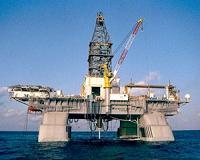 Hayward payoff ignites new BP controversy
Hayward payoff ignites new BP controversy
by Staff Writers
London July 26, 2010
BP chief executive Tony Hayward will walk away from the crisis-stricken British oil giant with a payoff of up to 18.5 million dollars, media reported Monday ahead of Hayward's departure.
The reports risked setting off a new controversy over the handling of the Gulf of Mexico oil disaster for which BP faces huge clean-up and damage costs and has been a public relations catastrophe for the conglomerate.
The BP board meets in London on Monday but the company insisted no final decision has been reached on a management change.
Directors gathered ahead of the release of second-quarter results on Tuesday which are expected to reveal a 30-billion-dollar (20-billion-pound, 23-billion-euro) provision for funding the disaster.
Reports said the announcement of Hayward's departure was imminent. He is expected to be replaced by Bob Dudley, the American executive now in charge of the Gulf of Mexico cleanup operation.
Hayward, who has struggled to maintain BP's reputation ever since the April 20 disaster which killed 11 workers, could get a pay-off and pension package worth around 12 million pounds, said The Times and the Financial Times newspapers.
The money is the equivalent of one year's salary plus a guaranteed pension.
Hayward has been criticised by President Barack Obama and other American leaders for his performance in countering the worst US environmental disaster. Comments such as "I would like my life back" and taking part in a yacht race as the oil slick grew all heightened anger in the United States.
BP said in a statement it noted "the press speculation" about the company's management and the provisions. "BP confirms that no final decision has been made on these matters."
"Any decisions will be announced as appropriate," it said.
Replacing Hayward would help the company to start to rebuild its 's severely tarnished profile.
In the Gulf of Mexico, the US government oil spill chief Thad Allen said BP's operation to plug the leaking well permanently had been delayed until the week beginning August 2.
Originally expected as early as Tuesday, Allen said BP had given a "refined and revised" timeline as it redeployed vessels and personnel following a recent storm.
The leak was sealed 11 days ago with a giant cap, but up to four million barrels (170 million gallons) of crude has already spewed into the sea since the deadly rig explosion.
Toxic crude has washed up on the shores of five US states on the Gulf Coast and vital tourism, fishing and oil industries in the region have been hit hard.
BP faces hundreds of pending lawsuits, not to mention hearings into the cause of the April 20 rig blast that should determine eventual liability.
The BBC report, quoting a senior BP source, said there was a "strong likelihood" Bob Dudley, who took over the day-to-day management of the spill response from Hayward last month, would be the new chief executive.
A BP spokesman told AFP only that "Tony Hayward is our chief executive. He has the full support of the board and management."
Hayward is a deeply unpopular figure in the United States.
He enraged residents of the stricken Gulf states when he told Britain's Sky News television on May 18: "I think the environmental impact of this disaster is likely to be very, very modest."
He also said at one point that he was as keen as anyone to deal with the problem because "I would like my life back", and at the height of the crisis went to watch his yacht compete in a race.
Accused of constantly trying to play down the impact of the disaster, BP is now in a separate controversy.
The US Senate is examining claims by lawmakers that BP pressured the British government to free convicted Lockerbie bomber Abdelbaset Ali Mohment al-Megrahi. The Libyan was freed on compassionate grounds because he has cancer almost a year ago.
BP's efforts to resolve the Gulf disaster were threatened last week by Tropical Storm Bonnie, but ships and drilling rigs are now back on site.
BP and US officials plan two operations to kill the well. The first, a "static kill", involves pumping heavy drilling fluid known as "mud" from the top of the well.
A week later, using a similar process, the drilling fluid, which is denser than oil, will be pumped via a relief well deep under the seabed, checking the flow of crude and allowing the reservoir to be sealed with cement.
Share This Article With Planet Earth
Related Links
Powering The World in the 21st Century at Energy-Daily.com

 Alarm on Gulf oil rig muted before blast: witness
Alarm on Gulf oil rig muted before blast: witness
New Orleans (AFP) July 23, 2010
An alarm that should have alerted workers on the Deepwater Horizon oil rig to a deadly build-up of gas that sank the platform, sparking a huge oil spill, had been muted months before, a former rig worker said Friday.
The alarm system which uses lights and alarms to warn of fire or high-levels of toxic or explosive gases, had been "inhibited," Mike Williams, the chief electronics technician o ... read more
|
 |
|

 Alarm on Gulf oil rig muted before blast: witness
Alarm on Gulf oil rig muted before blast: witness